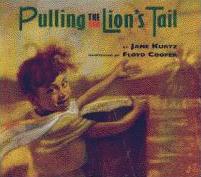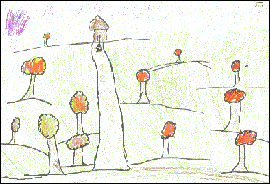
PULLING THE LION'S TAIL: Simon & Schuster (c) 1995, illustrated by Floyd Cooper
In a story about dealing with grief and adjusting to a new family, Almaz
goes looking for a way to gain her stepmother's love and finds both
patience and love. Almaz is a strong character who takes risks and finds
her own way, while supported by her wise grandfather, and this story
(based on an Ethiopian folktale) is full of the cultural details of life
in Ethiopia.
"Readers of all types will identify with Almaz's longing for love and acceptance and someone to care for her." Children's Book Review Magazine
"...for all who struggle with issues that require patience, this tale is a balm to the spirit and to all the spirits that move about." Five Owls
NCSS-CBC Notable Children's Trade Book in the Field of Social Studies
Young Book Trust's 100 Best Books of 1996 (British version): "Glowing
illustrations accompany this deceptively simple traditional Ethiopian tale."
--Read Pulling the Lion's Tail in connection with Sarah, Plain and Tall for a look at two girls, in two different cultures, forging a relationship with a new mother. Add Black-Eyed Susan by Jennifer Armstrong (Crown, 1995), for a look at a ten-year-old girl in Dakota Territory, with a mother who is struggling to overcome feelings of loneliness and isolation.
--Or look at other books on death and coping with loss, such as The Carousel by Liz Rosenberg (Harcourt 1995).
--Or look at other stepparent books, including When We Married Gary by Anna Grossnickle Hines (Greenwillow, 1996) and Mountain Wedding by Faye Gibbons (Morrow, 1996).
--Use Cinderella stories from all over the world to
start a discussion on the idea of the "wicked
stepmother."
--Look at other variants of the lion's tail folktale:
--Other lion books:
--Other stepparent books:


Student illustrations of PULLING THE LION'S TAIL.
For a "blank book" of
the story, ready for illustration, contact Jane.
Here's how a librarian described meeting Floyd Cooper at a bookstore and watching him show how he does his illustrations:
"He was relatively soft spoken but so gentle and full of quiet humor. He paints with very watery oil paint on an art board. The color is that light brown he uses so much. It dries for about ten minutes. He then takes a kneaded eraser (it's almost like putty) and begins to lift off the paint with it, with gentle strokes and touches. When the paint is really dry, he begins to add the colors on top. It was so amazing to observe."

Floyd Cooper